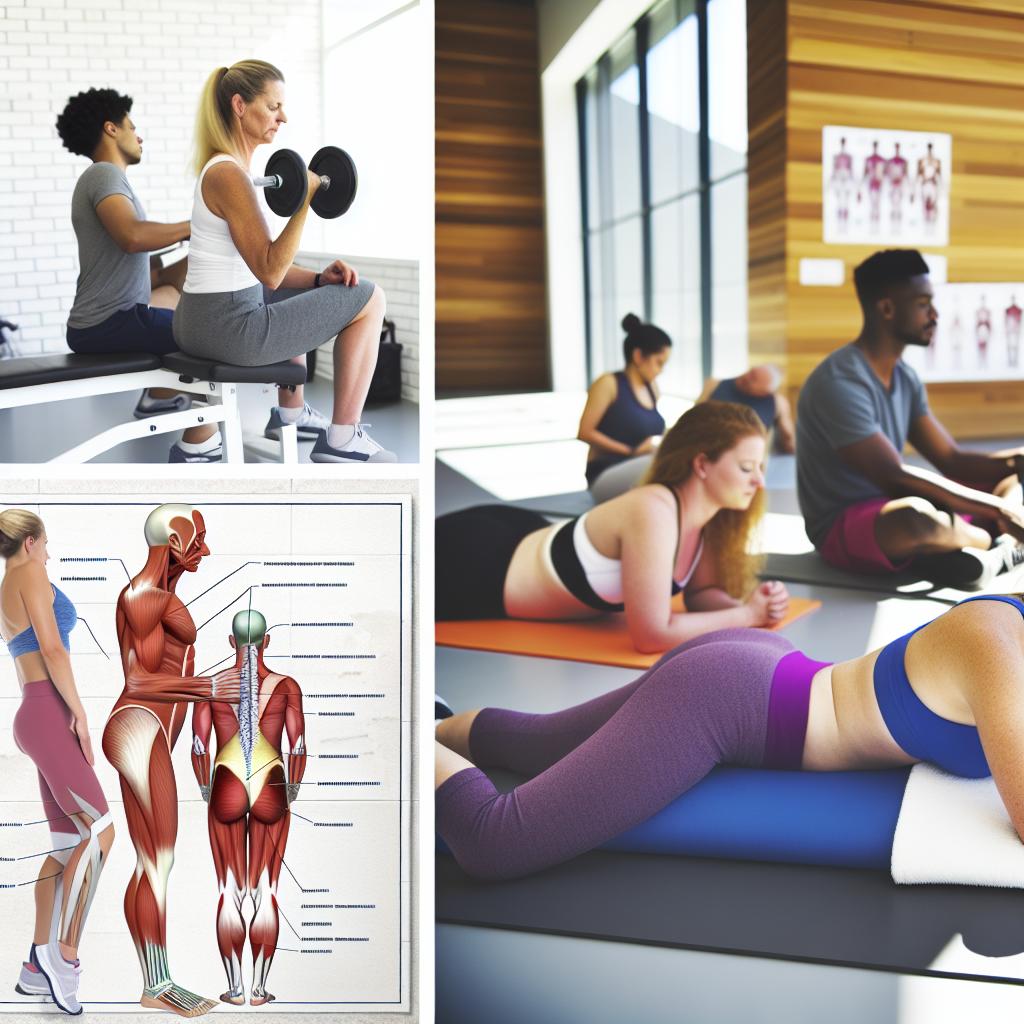Lower back pain affects millions, sparking debate over the best approach for relief: should you rest or engage in exercise? Understanding the balance between movement and recovery is crucial, as staying active can considerably alleviate pain and improve overall function. This article explores expert insights on managing lower back discomfort through exercise versus rest.
## Understanding Lower Back Pain: The Debate Between rest and Exercise
Lower back pain is a common issue that can be managed through different approaches,primarily centered around rest and exercise. While **rest** might seem like a comforting solution, research suggests that prolonged inactivity can actually exacerbate symptoms and lead to stiffness. Many health experts advocate for a balanced approach that incorporates both rest and gradual exercise to promote recovery.
the Role of Rest
Short-term rest is crucial, especially instantly following an injury. However, relying solely on rest can lead to deconditioning and increased pain. Here are some key points regarding effective rest:
- duration: Limit rest to 1-2 days for acute pain.
- Position: Use supportive pillows to maintain spinal alignment.
- Activity Modification: Avoid activities that exacerbate pain but do not eliminate movement fully.
Benefits of Exercise
Engaging in light, controlled exercises can expedite healing and improve mobility. Exercise strengthens the muscles supporting the spine and enhances versatility. Consider these approaches:
Recommended Exercises
- Pelvic Tilts: Lie on your back with knees bent; flatten the lower back against the floor by tightening abdominal muscles. Hold for 10 seconds, repeat 10 times.
- Knees to Chest Stretch: lie on your back, pull one knee to your chest while keeping the other foot on the floor. Hold for 15-30 seconds, switch legs and repeat 3 times.
- Cat-Cow stretch: Start on hands and knees; alternate between arching your back (cat) and dropping your belly (cow) to enhance spinal flexibility.
Finding Balance
The ideal strategy for managing lower back pain is a combination of rest and specific exercises tailored to individual capabilities. gradually reintroducing movement can restore function and alleviate discomfort. Always consult with a healthcare professional for personalized recommendations.
## the Role of Rest in Lower Back Pain Management: Insights from Experts
The Importance of active recovery
When managing lower back pain, rest plays a nuanced role. While many individuals instinctively choose bed rest during painful episodes,evidence suggests that prolonged inactivity can actually hinder recovery. Experts reccommend incorporating active recovery methods, such as gentle movement and stretching, into your routine.
Effective Active Recovery Strategies
- Short Walks: Aim for 5-10 minute walks a few times a day to promote blood flow without overstraining.
- Gentle Stretching: Perform simple stretches tailored for back health to enhance flexibility and reduce stiffness. Consider exercises such as the knee-to-chest stretch or the cat-cow stretch.
- Core Strengthening: Focus on exercises that strengthen abdominal and back muscles, supporting the spine. Examples include pelvic tilts and bridging exercises.
Understanding the Risks of Prolonged Bed Rest
Research indicates that extended bed rest may contribute to a prolonged recovery from chronic back pain. It is crucial to strike a balance between adequate rest and activity.maintaining a level of movement assists in keeping muscles engaged and supports overall spinal health.Consider the following:
Guidelines to Avoid excessive Sitting or Laying
- Limit lying down to short periods (1-2 hours) and gradually integrate movement as tolerated.
- Use supportive cushions or ergonomic chairs when seated to reduce strain.
- Incorporate light strength training or yoga sessions, focusing on proper form to prevent injury.
while rest is essential during episodes of lower back pain, experts advocate for a proactive approach. Engaging in light activity as pain allows not only fosters healing but also helps prevent further episodes, contributing to a more resilient and healthy back.
## Benefits of Exercise for Lower Back Pain Relief: What Experts Say
Physical Activity Supports Recovery
Experts emphasize that staying physically active is crucial for individuals experiencing lower back pain. Unlike the customary belief that rest is beneficial,engaging in appropriate exercises can definitely help alleviate pain and enhance mobility.Regular physical activity improves blood flow to the muscles, which promotes healing and reduces stiffness. Additionally, exercise contributes to overall fitness, combating the low fitness levels often associated with chronic pain conditions [[3]].
Recommended Exercises for Relief
Incorporating specific exercises tailored for lower back pain can greatly enhance your recovery process. Here are some effective options:
- Stretching: Gentle stretches can help relieve tension in the lower back muscles. Consider the following stretches:
- Cat-Cow Stretch
- Child’s Pose
- Knees-to-Chest Stretch
- Strengthening: Strength exercises for the core and back muscles provide stability and support, such as:
- Planks
- Glute Bridges
- Bird-Dog Exercise
Psychological Benefits of Exercise
Physical activity not only addresses physical symptoms but also offers psychological benefits. Many individuals with lower back pain experience symptoms of anxiety and depression. Exercise releases endorphins, which can uplift mood and lessen feelings of distress. By incorporating a regular exercise routine, individuals may also experience improved sleep patterns, further aiding in pain management and overall wellness [[1]] [[2]].
Tips for Starting an Exercise Routine
For those hesitant to begin an exercise regimen, consider the following steps:
- Start with short sessions (10-15 minutes) and gradually increase duration.
- Choose low-impact activities, such as walking or swimming.
- Consult with a healthcare provider or physical therapist to personalize your exercise plan.
## Practical Exercises to Alleviate lower Back Pain: Actionable Techniques
Effective Stretching Techniques
Engaging in regular stretching can significantly alleviate lower back pain. Consider incorporating the following stretches into your routine:
- Child’s Pose: Kneel on the floor, sit back on your heels, and extend your arms forward on the ground.Hold for 30 seconds to release tension.
- Cats and Dogs Stretch: Start on all fours. Alternate between arching your back towards the ceiling and dipping it towards the ground. Repeat for 5-10 cycles.
- Knees to Chest: Lie on your back and pull your knees toward your chest. Hold for 20-30 seconds to stretch the lower back muscles.
Strengthening Exercises
Building core strength is essential for supporting your back. Try these highly recommended exercises:
- Plank: Position yourself as if you are going to do a push-up, holding your body in a straight line. Engage your core and hold for 20-30 seconds.
- Bridges: Lie on your back with your knees bent. Lift your hips off the ground while tightening your glutes. Hold for a few seconds and lower down. Repeat 10-15 times.
- Bird-Dog: Start on all fours, extend your right arm forward and left leg back.Hold for a few seconds, then switch sides. Aim for 10 repetitions per side.
Incorporating Aerobic Fitness
Adding aerobic exercises into your weekly routine also helps improve overall fitness and reduce lower back pain:
- Walking: Aim for 20-30 minutes of brisk walking daily.
- Swimming: Provides a low-impact option that relieves pressure on the spine.
- Cycling: A great way to strengthen your back and preserve mobility.
| Exercise Type | Benefits |
|---|---|
| Stretching | Increases flexibility and reduces tension |
| Strengthening | Supports the spine by building core muscles |
| Aerobic Exercise | Improves overall fitness and circulation |
## Balancing Rest and Activity: Finding the Right Approach to Lower Back Pain
Understanding the Balance
When managing lower back pain, finding a balance between rest and activity is crucial. While resting is importent to allow your body to recover,prolonged inactivity can lead to stiffness and weakened muscles. Experts recommend a gradual return to activity that includes both rest and movement to optimize recovery.
Resting Wisely
During acute lower back pain, short periods of rest can help alleviate discomfort. However, resting for more than a couple of days can be counterproductive. Consider these tips:
- Limit bed rest: Aim for no more than 1-2 days of strict bed rest.
- Use supportive surfaces: When resting, ensure your mattress provides the necessary support.
- Incorporate gentle stretches: Engage in light stretches to maintain flexibility.
Engaging in Activity
Physical activity plays a crucial role in recovery. Experts suggest starting with low-impact exercises that strengthen core muscles, as this provides stability to the spine. Follow these steps for safe engagement in activity:
- begin with walking: Start with short walks,gradually increasing your distance.
- Try gentle stretching exercises: Figure 4 stretch and child’s pose can definitely help relieve tension.
- Consult a professional: Work with a physical therapist to design an individualized exercise plan.
Sample Stretching Routine
| Exercise | Duration | Repetitions |
|---|---|---|
| Child’s Pose | 30 seconds | 2-3 |
| Figure 4 Stretch | 30 seconds (each side) | 2-3 |
| Knees to Chest Stretch | 30 seconds | 2-3 |
effectively balancing rest and activity is integral to managing lower back pain. Prioritize gradual movement while allowing for necessary rest to support your recovery journey.
## Common Challenges in Deciding between Rest and Exercise for Lower Back Pain
Understanding the dilemma
Deciding between rest and exercise for managing lower back pain can be challenging due to conflicting advice and personal experiences. Many individuals recovering from injuries may initially opt for prolonged rest, fearing that movement could exacerbate their pain.However,resting for too long can lead to muscle atrophy and stiffness,possibly worsening back pain in the long run.
Key Challenges to Consider
- Identifying Pain sources: It is essential to distinguish between pain caused by injury and normal muscle soreness from exercise.
- Personalization of Recovery: Each person’s pain threshold and recovery pace are unique; what works for one individual may not be effective for another.
- Fear Avoidance: Fear of pain during activity can lead to avoidance behaviors, making individuals reluctant to engage in necessary movement.
Steps to Find Balance
- assess your pain level: Keep a diary of your pain and activities.
- consult a professional: Engage a physical therapist to devise a tailored plan.
- Incorporate gentle exercises: Start with low-impact options such as walking or swimming.
- Listen to your body: Gradually increase intensity and duration based on comfort levels.
actionable Strategies
Stretching exercises can also be highly beneficial. Here are a few to consider:
- Cat-Cow Stretch: This promotes flexibility in the spine.
- Knees-to-Chest Stretch: This helps relieve tension in the lower back.
- Child’s Pose: A gentle stretch to open the hips and elongate the spine.
By balancing rest and exercise appropriately, many individuals can find relief from lower back pain while gradually increasing their activity levels.
## Expert-Recommended Stretches and Movements for Lower Back Pain Relief
Essential Stretches for Lower Back Pain Relief
incorporating specific stretches into your daily routine can significantly alleviate lower back pain and improve overall mobility. Its crucial to perform these stretches gently and never push into pain. Here are some expert-recommended stretches:
- Knee-to-Chest Stretch: lie on your back with knees bent. Gently pull one knee towards your chest while keeping the other foot on the floor, holding for 15-30 seconds before switching sides.
- Cat-Cow Stretch: Start on all fours. Alternate between arching your back up (cat) and lowering your belly towards the floor (cow), coordinating your breath with each movement for improved flexibility.
- Child’s Pose: Kneel on the floor,sit back on your heels,and extend your arms forward on the ground,allowing your back to elongate. Hold this position for 30 seconds to relieve tension.
Strengthening Exercises for Long-Term Relief
Engaging in strengthening exercises not only enhances back support but also prevents future discomfort. Consider these effective movements:
Pelvic Tilt
Lie on your back with knees bent and feet flat. Tighten your abdominal muscles, flatten your back against the floor, and hold for 10 seconds. Repeat 10 times.
Bridge Exercise
Still on your back, bend your knees and keep feet flat. Lift your hips towards the ceiling, squeezing your glutes at the top.Hold for 5 seconds, then lower. Aim for 10-15 repetitions.
Daily movement Recommendations
Incorporating regular movement throughout your day can be just as beneficial as set exercise routines.Try to:
- Take short breaks to stand and stretch every hour, notably if sitting for long periods.
- Engage in low-impact activities like walking or swimming to maintain mobility without strain.
- Prioritize good posture when sitting, standing, and lifting to reduce unnecessary tension in the back.
## Home Remedies and Lifestyle Changes to Support Recovery from Lower Back Pain
Importance of Movement
For those experiencing lower back pain, staying active is crucial. While it is advisable to rest for the first few days to reduce inflammation, prolonged inactivity can worsen the condition. It’s important to gently resume normal physical activities as soon as possible. engaging in light activities can definitely help maintain mobility and reduce stiffness,which is vital for recovery [1].
Effective Home Remedies
Core Strengthening Exercises
Incorporating core-strengthening exercises into your routine can provide crucial support to your lower back. Some effective exercises include:
- Pelvic Tilts
- Bird-dog
- Modified Plank
These exercises help stabilize the spine and distribute weight more evenly, thus alleviating pressure on the lower back [3].
Stretching Techniques
Incorporating stretching into your daily routine can also relieve tension in the lower back. Here are two simple stretches:
- Hamstring Stretch: Sit with one leg extended. Reach towards your toes and hold for 20-30 seconds.
- Child’s Pose: Kneel on the floor and sit back onto your heels, stretching your arms forward on the ground.
Hold each stretch for at least 15-30 seconds, breathing deeply to enhance relaxation.
Lifestyle Adjustments
Making certain lifestyle changes can further support recovery from lower back pain. Consider the following:
- Maintain a healthy weight to reduce strain on the lower back.
- Use ergonomic furniture to promote proper posture while sitting.
- Incorporate regular physical activity into your daily routine.
These adjustments not only facilitate healing but also prevent future occurrences of back pain [2].
## How to Create a Personalized Plan for Lower Back Pain Management: Tips and Techniques
Assess Your Condition
before you create a personalized plan for managing lower back pain, it’s crucial to assess your specific condition. Consider the following factors:
- Severity: Is the pain mild, moderate, or severe?
- Duration: How long have you been experiencing pain?
- Type: is it sharp, dull, or achy?
Understanding these elements will help you tailor your approach to what works best for you.
Incorporate Exercise and Movement
Research indicates that engaging in regular physical activity can significantly reduce lower back pain. Here are some effective exercises:
- Stretching: Gentle stretches can improve flexibility and reduce tension.
- strengthening: Focus on core strength to support your lower back.
Example Stretches
Here are a couple of stretches you can do at home:
- Child’s Pose: Kneel on the floor, sit back on your heels, and reach your arms forward on the ground.
- Cobra Stretch: Lie face down, place your hands under your shoulders, and push your upper body off the ground.
Establish a Routine
Creating consistency in your pain management strategy is vital. Try to:
- Schedule daily exercises: Aim for at least 30 minutes of gentle activity.
- Monitor your progress: Keep a diary of your pain levels and activities.
This will help you see what works and adjust your plan as necessary, promoting a proactive approach to your back health.
consult Professionals
Regular consultations with healthcare providers, including physical therapists or chiropractors, can offer additional insights and personalized techniques. They can help:
- Identify specific exercises tailored to your pain.
- Teach proper body mechanics to avoid aggravating pain.
Incorporating professional guidance into your plan can enhance your recovery and improve your daily functioning.
Faq
### Is resting really beneficial for lower back pain?
Resting has traditionally been viewed as a way to alleviate lower back pain; though, recent research indicates that prolonged periods of inactivity can actually worsen the problem. Experts now recommend a balanced approach that includes both rest and gentle movement. Engaging in light activities can help maintain flexibility and prevent stiffness in the back.- **Key Insight**: Instead of complete rest, consider gentle movements such as walking, stretching, or specific back exercises.
– **Takeaway**: aim to break up periods of inactivity with some form of movement every hour to support spinal health.
### How can exercise help manage lower back pain?
Exercise is an effective treatment for managing lower back pain. It can enhance strength, flexibility, and posture, which are vital for reducing strain on the back. Structured exercise programs—often supervised by a physical therapist—can be particularly beneficial for chronic pain sufferers.
– **Types of Exercise**: Low-impact activities such as swimming, yoga, and specific strengthening exercises are recommended.
– **Benefits of Exercise**: Regular physical activity not only helps relieve pain but also reduces the risk of future episodes, providing a long-term solution.
### What specific exercises are most effective for lower back pain?
When choosing exercises to alleviate lower back pain, it’s critically important to focus on low-impact activities that strengthen the core and improve flexibility. Experts frequently recommend the following:
– **Core Strengthening**: Planks, pelvic tilts, and bridges can build strength in the muscles supporting your spine.
– **flexibility Exercises**: Gentle stretching can significantly help reduce tension in the lower back. Try child’s pose or knee-to-chest stretches to relieve discomfort.Make sure to listen to your body and avoid any movements that cause pain. It’s also wise to consult a healthcare provider or physical therapist before starting a new exercise regimen.
### How does posture influence lower back pain?
Proper posture is crucial in preventing and managing lower back pain.Poor posture can put excessive pressure on the spinal structures, leading to discomfort and long-term issues. Being mindful of your posture while sitting, standing, and lifting can make a significant difference.
– **Posture Tips**:
– **Sitting**: Keep your back straight and shoulders relaxed, with your feet flat on the floor.
– **Standing**: Distribute your weight evenly on both feet and avoid locking your knees.
Improving posture not only helps relieve pain but also promotes better overall body mechanics,reducing strain on the back.
### When should I consider rest over exercise for lower back pain?
While movement is generally beneficial, there are times when rest may be necessary, particularly in the immediate aftermath of an injury. If you experience acute pain, short durations of rest may allow your back to recover. However, prolonged inactivity should be avoided.- **Guidance for Resting**:
– Take short breaks from activity but avoid lying down for extended periods.
– Gradually reintroduce light activities as pain subsides.
If pain persists despite these measures,it is indeed advisable to consult a healthcare professional to rule out serious conditions and discuss next steps.
### Can choice therapies complement exercise for lower back pain management?
Yes,alternative therapies such as acupuncture,chiropractic care,and massage therapy can effectively complement exercise for managing lower back pain. These therapies can provide immediate relief and enhance the benefits of your exercise routine.
– **Integrative Approach**: Combining traditional exercise with alternative therapies can target different aspects of pain and improve overall results.- **Consultation**: Always consult with a healthcare provider before integrating alternative therapies into your pain management plan to ensure they are appropriate for your specific situation.
### How long should I expect to change my lower back pain with exercise and rest?
The timeline for experiencing changes in lower back pain can vary significantly based on factors such as the severity of pain, underlying conditions, and adherence to a proposed regimen of rest and exercise. Patients may frequently enough notice improvements within a few weeks, especially when incorporating a combination of gentle movements and core strengthening exercises.
– **Persistence is Key**: Consistency in following the recommended practices is essential for long-term relief.- **track Progress**: Keep a journal of your activities and pain levels to identify patterns and adaptations to your management strategies.
Ultimately, a tailored approach, developed in consultation with healthcare professionals, will yield the best results for managing lower back pain.
The Way Forward
## Conclusion: Finding What Works for You
In the quest to alleviate lower back pain, understanding whether rest or exercise is more beneficial is essential. Here are key takeaways to remember:
– **Listen to Your Body**: Pay attention to how your body responds to rest and exercise. Everyone’s situation is unique, and what works for one person may not work for another.
– **Consult Professionals**: Always talk to a healthcare provider before making significant changes to your routine. They can provide personalized advice based on your condition.
- **Incorporate Movement**: Gentle exercises, such as stretching or walking, can frequently enough provide relief without straining your back. Regular movement may also prevent future issues.- **Rest Wisely**: While prolonged rest can sometimes worsen pain, short bouts of restorative rest may help in the recovery process. Find a balance that feels right for you.
– **Gradual Progression**: If you choose to incorporate exercise, start slowly. Gradually increase intensity and duration as your body adapts.
### Moving Forward
No one-size-fits-all solution exists for lower back pain, but through informed decision-making and careful monitoring of your body’s feedback, you can find a path that alleviates your discomfort and enhances your quality of life.remember, perseverance is key—both rest and exercise have their place in recovery. Stay committed to your health journey, and seek support when needed. You’ve got this!










